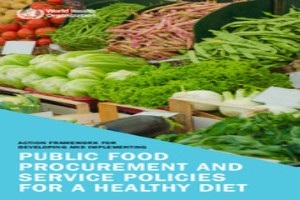
Geneva: Unhealthy diet continues to be a leading risk factor for death and disability globally. Around 8 million deaths every year are attributable to excess consumption of food high in sodium and salt, sugars and fats (particularly trans-fatty acids – trans fats), and by inadequate consumption of whole grains, pulses, vegetables and fruits. Unhealthy dietary practices prevail across different population groups and geographical regions. For example, school-aged children seldom meet recommended fruit and vegetable intake, frequently consume sugar-sweetened beverages, and often eat at fast-food outlets.
Rapidly changing food environments, with increased availability of unhealthy food, are not conducive to promoting healthy diets. Obesity, and maternal and child undernutrition are responsible for an additional 8 million deaths. Together, these risks contribute to around one third of all deaths, and result in costs for individuals, families, communities and governments in terms of illness, disability, health expenditures and lost productivity.
A new World Health Organisation (WHO) Action framework for developing and implementing public food procurement and service policies for a healthy diet aims to increase the availability of healthy food through setting nutrition criteria for food served and sold in public settings. The action framework also aims to reduce preventable diseases and deaths from high consumption of sodium and salt, sugars and fats, particularly trans fats, and inadequate consumption of whole grains, legumes, vegetables and fruit.
“Public places that serve the entire community, including our most vulnerable populations, must be places where healthy diets are promoted not discouraged,” said Dr Tedros Adhanom Ghebreyesus, WHO Director-General at the release of the new framework here today. He said: “Now is the time for governments to lead by example through ensuring that the food served or sold in public settings contributes to healthy diets and saves lives. No public funds should be spent on food contributing to unhealthy diets.”

Consuming a healthy diet from pre-birth to the last days of life is vital to prevent all forms of malnutrition as well as diabetes, cancers and other noncommunicable diseases (NCDs). The new action framework serves as a tool for governments to develop, implement, monitor and evaluate public food procurement and service policies that align with the core principles of healthy diets as outlined in existing WHO recommendations:
- limit sodium consumption and ensure that salt is iodized;
- limit the intake of free sugars;
- shift fat consumption from saturated fats to unsaturated fats;
- eliminate industrially-produced trans fats;
- increase consumption of whole grains, vegetables, fruit, nuts and pulses; and
- ensure the availability of free, safe drinking water.
Urgent action is needed to stop the growing consumption of foods and beverages that lead to unhealthy diets. Of greatest concern are excess consumption of sodium and salt, sugars and fats, particularly trans-fatty acids (trans fats); and low consumption of whole grains, pulses, vegetables and fruits. Governments worldwide have a unique opportunity and responsibility to lead by example through the implementation of healthy public food procurement and service policies, requiring that all foods and beverages served or sold in public settings contribute to the promotion of healthy diets.
Public settings, such as schools, childcare centres, nursing homes, hospitals and correctional facilities and all other canteens of public institutions, can play a key role in ensuring people are provided with healthy food and helping prevent the 8 million annual deaths currently caused by unhealthy diets.
By ensuring that healthier foods and beverages are offered, governments can enable the population to consume healthy diets and this can reduce the burden of all forms of malnutrition, and premature death and disability from preventable diet-related noncommunicable diseases.
Healthy public food procurement and service policies can also contribute to increased productivity and educational attainment; create purchasing power, which can increase demand for, and availability of, healthier food and reduce costs; strengthen local food systems by promoting purchasing from local producers; and improve health equity across populations.
A healthy public food procurement and service policy establishes nutrition criteria to increase the availability of foods and beverages that promote healthy diets, and/or limit or prohibit the availability of foods and beverages that contribute to unhealthy diets. Effective nutrition criteria are mandatory, specific and enforceable, and applicable to all government food purchases and all food served or sold in public settings, according to the new WHO framework.
The WHO stated that this action framework can serve as a reference when developing a new public food procurement and service policy, strengthening or expanding an existing policy for procurement or service of food, or introducing food into general non-food procurement policies. It is intended for use by government policy makers or programme managers working on public food procurement or service, at either a national or a subnational level, including at regional, provincial and city levels.
“The action framework proposes key policy steps to make public food procurement and service healthier. It consists of four sections, each based on the policy cycle (see the figure). These key policy steps do not need to be implemented in a particular sequence; in practice, real-life policy processes may jump back and forth between steps,” it said.
– global bihari bureau





